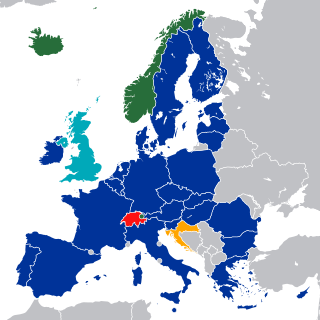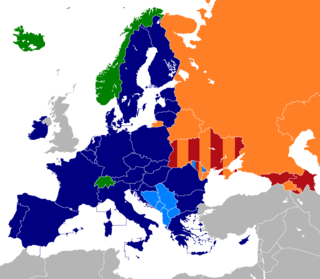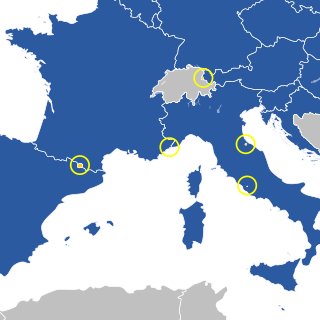The General Agreement on Tariffs and Trade (GATT) is a legal agreement between many countries, whose overall purpose was to promote international trade by reducing or eliminating trade barriers such as tariffs or quotas. According to its preamble, its purpose was the "substantial reduction of tariffs and other trade barriers and the elimination of preferences, on a reciprocal and mutually advantageous basis."

The European Economic Area (EEA), which was established via the EEA Agreement in 1992, is an international agreement which enables the extension of the European Union (EU)'s single market to non-EU member parties. The EEA links the EU member states and three European Free Trade Association (EFTA) states into an internal market governed by the same basic rules. These rules aim to enable free movement of labour, goods, services, and capital within the European Single Market, including the freedom to choose residence in any country within this area. The EEA was established on 1 January 1994 upon entry into force of the EEA Agreement. The contracting parties are the EU, its member states, and three EFTA member states.
The European Union has a number of relationships with nations that are not formally part of the Union. According to the European Union's official site, and a statement by Commissioner Günter Verheugen, the aim is to have a ring of countries, sharing EU's democratic ideals and joining them in further integration without necessarily becoming full member states.

At present, there are four multi-lateral free trade areas in Europe, and one former free trade area in recent history. Note that there are also a number of bilateral free trade agreements between states and between trade blocks; and that some states participate in more than one free trade area.

A Trade and Investment Framework Agreement (TIFA) is a trade pact that establishes a framework for expanding trade and resolving outstanding disputes between countries.

The EFTA Surveillance Authority (ESA) monitors compliance with the Agreement on the European Economic Area (EEA) in Iceland, Liechtenstein and Norway; the European Free Trade Association (EFTA) States which are a part of the EEA Agreement, allowing them to participate in the Internal Market of the European Union.

The relations between Switzerland and the European Union (EU) are framed by a series of bilateral treaties whereby the Swiss Confederation has adopted various provisions of European Union law in order to participate in the Union's single market, without joining as a member state. All but one of Switzerland's neighbouring countries are EU member states.

A Transatlantic Free Trade Agreement (TAFTA) is a proposal to create a free-trade agreement covering Europe and North America, on both sides of the Atlantic Ocean. Such proposals have been made since the 1990s. Since 2013 an agreement between the United States and the European Union (EU) has been under negotiation: the Transatlantic Trade and Investment Partnership. If an agreement is reached and ratified on both sides, it could at least in theory be expanded to include the European Free Trade Association (EFTA). Canada and Mexico both have free trade agreements with both the EU and EFTA.

There are a number of microstates in Europe. While there is no clear consensus on which political units qualify as "microstates", most scholars view Andorra, Liechtenstein, Monaco, San Marino and the Vatican City as examples of such states. At the same time, some academics dispute even qualifying Vatican as a true state arguing that it does not meet the "traditional criteria of statehood" and that the "special status of the Vatican City is probably best regarded as a means of ensuring that the Pope can freely exercise his spiritual functions, and in this respect is loosely analogous to that of the headquarters of international organisations." According to the qualitative definition of microstates suggested by Dumienski (2014), microstates can also be viewed as "modern protected states, i.e. sovereign states that have been able to unilaterally depute certain attributes of sovereignty to larger powers in exchange for benign protection of their political and economic viability against their geographic or demographic constraints." And indeed, all of the European microstates are sovereign states that function in a close association with their respective larger neighbour. Currently, all of the European microstates have some form of relations with the European Union.

Iceland–South Korea relations are primarily based on cooperation over maritime issues, such as whaling and bottom trawling, and on bilateral trade in technology and fish products. Diplomatic relations between Iceland and the Republic of Korea were established on October 10, 1962 according to the Korean Ministry of Foreign Affairs. The Icelandic Ministry for Foreign Affairs gives the date as 19 April 1982. Iceland's Embassy in Beijing is accredited South Korea, and Iceland also has two honorary consulates in Seoul. South Korea's embassy in Oslo, Norway is accredited to Iceland, and South Korea has an honorary consulate in Reykjavík.
Integration is a political and economic agreement among countries that gives preference to member countries to the agreement. General integration can be achieved in three different approachable ways: through the World Trade Organization (WTO), bilateral integration, and regional integration. In bilateral integration, only two countries economically cooperate with one another, whereas in regional integration, several countries within the same geographic distance become joint to form organizations such as the European Union (EU) and the North American Free Trade Agreement (NAFTA). Indeed, factors of mobility like capital, technology and labour are indicating strategies for cross-national integration along with those mentioned above.
The ASEAN–India Free Trade Area (AIFTA) is a free trade area among the ten member states of the Association of Southeast Asian Nations (ASEAN) and India. The initial framework agreement was signed on 8 October 2003 in Bali, Indonesia. and the final agreement was on 13 August 2009. The free trade area came into effect on 1 January 2010. India hosted the latest ASEAN-India Commemorative Summit in New Delhi on 26 January 2018. In the financial year 2017-18, Indo-ASEAN bilateral trade grew by almost 14% to reach US$81.3 billion. India's imports from ASEAN were valued at US$47.13 billion while its exports to ASEAN stood at US$34.2 billion.

Relations between the Principality of Liechtensteinand the European Union (EU) are shaped heavily by Liechtenstein's participation in the European Economic Area (EEA).

Relations between the European Union (EU) and Japan date back to 1959. They have a strong trade relationship, particularly in investment flows.
A guillotine clause is a stipulation that an adoption of a contract package depends on the adoption of all of the individual treaties or contracts included. Under the guillotine clause, if only one treaty or contract is either not accepted by an involved party or canceled later, all treaties or contracts are then deemed not accepted or terminated.

The United Kingdom's post-Brexit relationship with the remaining European Union members could take several forms. A research paper presented to the UK Parliament in July 2013 proposed a number of alternatives to membership which would continue to allow access to the EU internal market. These include remaining in the European Economic Area (EEA) as a European Free Trade Association (EFTA) member, or seeking to negotiate bilateral terms more akin to the Swiss model with a series of interdependent sectoral agreements. An exit from the EU without a trade agreement is known as a no-deal Brexit.
In British politics "Norway-plus" is a proposal for a post-Brexit settlement. Proposed in November 2018 as an alternative to the Chequers plan, it would consist of membership of the European Free Trade Association (EFTA) and of membership of the European Economic Area (EEA) as an EFTA member state, combined with a separate customs union with the EU to create a trade relationship similar to that between the EU and its member states today, with the exception of the political representation in the EU's bodies. Michel Barnier, the EU’s Chief Negotiator, has always said that a model that combined EEA/EFTA and a customs union was one that he would be happy to consider.











